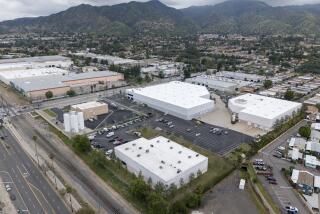Lab Suspends 6 as Hunt Widens for Lost Nuclear Data
WASHINGTON — The Los Alamos National Laboratory suspended six managers and senior scientists Tuesday as part of a widening criminal investigation into the disappearance of two computer hard drives filled with nuclear weapon secrets, Energy Department officials said.
Among those placed on leave with pay is the director of the lab’s Nuclear Emergency Security Team, a little-known group that assists the FBI in investigations of terrorist threats involving nuclear weapons, officials said.
FBI agents will begin administering polygraph tests to eight team scientists today, including one who has given a series of conflicting answers in interviews so far, officials said.
The highly classified material disappeared more than a month ago from the locked compartment of a locked bag inside a heavily guarded vault in the main administration building of the beleaguered New Mexico facility run by the University of California.
The FBI has not ruled out espionage in the case, and the U.S. intelligence community has been asked to help prepare a damage assessment of the potential effect if the hard drives were obtained by a foreign power, an Energy Department official said.
More than 200 people have been interviewed so far, but the investigation appears to be focusing on 28 Los Alamos scientists who were permitted “unescorted access” and were able to open the vault on their own.
Energy Department officials said that the lab does not require its staff to sign a log or any other document when classified material is taken from the high-security vault, so no written or electronic record apparently exists of who might have removed the portable hard drives.
In the first of what are likely to be a series of heated congressional hearings, legislators excoriated the lab for that lapse and for its failure to notify the Department of Energy and the FBI until three weeks after the hard drives first were reported missing on May 7. They were last seen in an inventory a month earlier.
Rep. Bart Stupak (D-Mich.) seemed especially astonished that the lab does not track who removes classified material from a high-security vault. He noted in caustic terms that even his hometown library in Menominee, Mich., keeps records when someone checks out a book.
“Most Americans would find it hard to believe that the Menominee public library has a more sophisticated tracking system for ‘Winnie the Pooh’ than Los Alamos has for highly classified nuclear weapons data,” Stupak told the oversight and investigations subcommittee of the House Commerce Committee. “That’s exactly the situation we’re faced with.”
Stupak also ridiculed the assertion by Edward J. Curran, the Energy Department’s director of counterintelligence, that no evidence points to espionage.
“How are we going to find out?” Stupak asked. “Does Mr. Curran expect someone from Baghdad or Beijing to call next year and ask for a software update?”
The acerbic criticism had a familiar bite since it echoed the lambasting the Los Alamos lab took last year when legislators charged that Chinese spies were running rampant and that security was routinely ignored.
Chinese espionage was never confirmed at the lab. But a federal grand jury indicted a Taiwan-born Los Alamos engineer, Wen Ho Lee, last December for allegedly copying a virtual library of nuclear weapon secrets onto an unsecure computer network open to the Internet and onto portable tapes. Lee, who is in jail awaiting trial, has pleaded not guilty to 59 felony counts.
John Browne, head of the lab, called the hard drive case “a serious security matter and extremely disturbing and disappointing to me both professionally and personally.”
He said in a statement that the lab has made “great strides” in improving security since the Lee case first exploded in headlines more than a year ago.
Browne said that he has ordered lab divisions with classified weapon information to stop normal work so employees can assess their security practices and consider improvements. A lab spokesman, Jim Danneskiold, said that thousands of lab employees are affected.
The missing hard drives were stored in a walk-in vault--about 10 feet wide and 20 feet long with two long tables and shelves--in the lab’s X Division, where Lee worked for nearly 20 years until he was fired in March 1999. About 300 physicists, engineers and others design and develop nuclear weapons in the X Division. Their cramped offices line a yellow cinder-block hallway on the third floor of the lab’s main office building.
Eugene E. Habiger, a retired Air Force general who is the Energy Department’s top security official, told the House hearing that the vault has “three levels of protection,” including a password, before authorized personnel are allowed to enter.
Beyond that, Habiger said, the hard drives were in “locked compartments” in a locked bag. Keys to the locks were attached to the bag and a spare set hung on the vault wall, he said. The vault has motion sensors and infrared sensors that would track an unauthorized entry.
But Habiger conceded that the lab does not require scientists to record when they remove classified material from the vault. “There is very little requirement to inventory classified material,” he said.
The bag belonged to Nuclear Emergency Security Team scientists, technicians and other nuclear weapon specialists from the Energy Department and its contractors. Officials said that data on the missing hard drives include information on various warheads and bombs, intelligence about terrorist groups and other classified material.
Darwin Morgan, a spokesman at the security team’s headquarters in Las Vegas, Nev., insisted that the group was not hampered by the loss of the hard drives. “Is NEST able to stand up and respond today? Yes, we can,” he said.
Morgan said that the team was created in 1975 and has several hundred members at the nation’s three nuclear weapon labs, as well as at other facilities. The group stores its heavy diagnostic equipment at Nellis Air Force Base outside Las Vegas and at Andrews Air Force Base outside Washington.
In a detailed account of events leading up to the disappearance, Habiger testified that two officials with clearance for “unescorted access” to the vault rushed to remove one of three mobile “kits” just before midnight on May 7 before a fast-approaching wildfire made access impossible.
“They went inside,” Habiger said. “They inventoried. . . . They could not feel the hard drives in the locked container” in the second kit. He said that they took hard drives from the third and “immediately evacuated” the area.
“The concern was to get an operational kit out of harm’s way,” he said. The security team took the materials to Sandia National Laboratories, 70 miles away in Albuquerque.
The Los Alamos lab was officially closed the next day, May 8, as the fire burned out of control. It did not begin to reopen until May 22. Habiger said that a “full-scale search” started two days later within the X Division and other areas where the security team had worked.
But, Habiger said, the Energy Department in Washington was not notified until late on June 1 that the hard drives were missing. He said that Curran informed the FBI the next day, and officials had a video conference with lab director Browne on June 5.
“Dr. Browne indicated that he had intensely searched the facility,” Habiger said. “They could not find the two missing hard drives.”
Habiger and Curran met that afternoon with senior FBI officials and a joint investigation was launched. Habiger flew to Los Alamos that night with about 25 FBI agents and Energy Department investigators. They began interviewing potential witnesses early the next morning, he said, while a separate search was launched at another of the nation’s nuclear labs, Lawrence Livermore National Laboratory in the San Francisco Bay Area.
Saying that he was “outraged” by the lapse, Energy Secretary Bill Richardson named former Republican Sen. Howard H. Baker Jr. of Tennessee and former Democratic Rep. Lee Hamilton of Indiana to head an independent panel that will review the security problems.
“We are not going to tolerate this,” Richardson said. “There will be accountability and disciplinary action.”
In a written statement, White House spokesman Joe Lockhart said that President Clinton expects the panel’s efforts “to be thorough, expeditious and conducted in a manner that does not interfere with the FBI’s investigation of this very serious matter.”
Republican senators accused the Clinton administration of stalling efforts to reform security at the nation’s nuclear labs. Sen. Jon Kyl (R-Ariz.) told reporters that the incident showed the “mind-set at Los Alamos continues to be more oriented toward laxity than security.”
Sen. Frank H. Murkowski (R-Alaska) compared the scandal to the wildfire that closed the lab last month. “It looks very much like our national security is kind of going up in smoke, like the area around Los Alamos.”
Murkowski, who heads the Senate Energy and Natural Resources Committee, with oversight over the Energy Department, aimed his sharpest barb at Richardson.
“You can point the finger at one man,” he said. Richardson “gave us the assurance that everything was under control. . . . Well, it isn’t.”
*
Times staff writer Nick Anderson contributed to this story.
More to Read
Sign up for Essential California
The most important California stories and recommendations in your inbox every morning.
You may occasionally receive promotional content from the Los Angeles Times.











